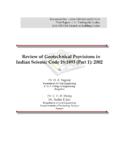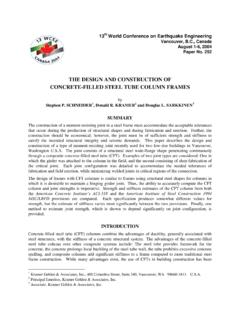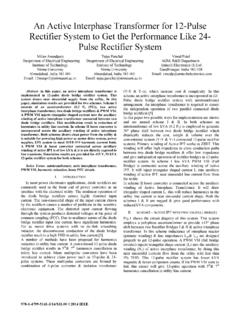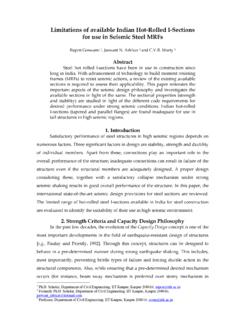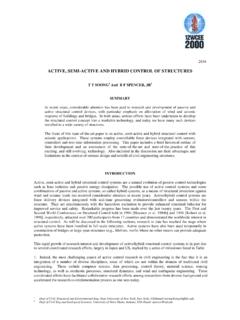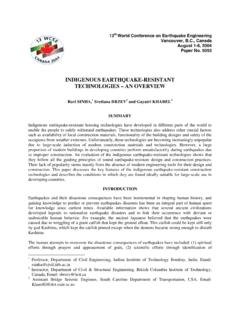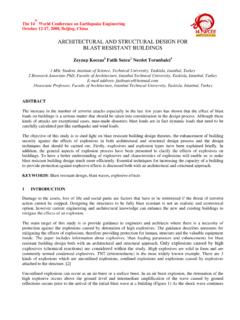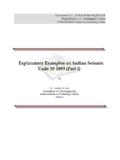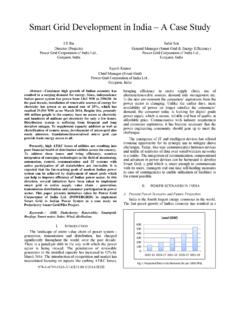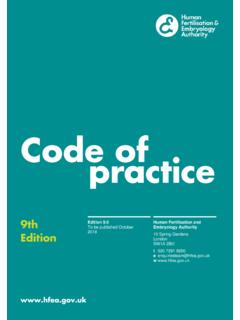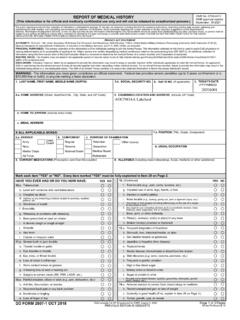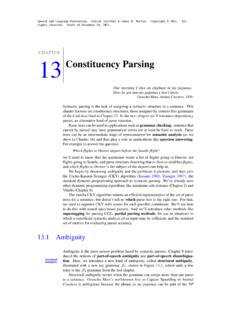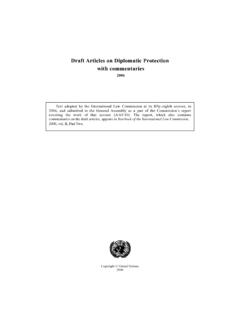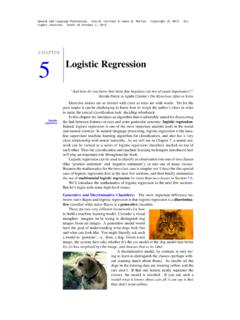Transcription of Structural Use of Unreinforced Masonry
1 Document No. :: :: Final Report :: A - Earthquake Codes IITK-GSDMA Project on Building Codes Structural Use of Unreinforced Masonry by Dr. Durgesh C. Rai Department of Civil Engineering Indian Institute of Technology Kanpur Kanpur With assistance from Mr. Sandeep Pal Ms. Ami Patwa Mr. Samaresh Paikara Mr. Ashish Narayan Department of Civil Engineering Indian Institute of Technology Kanpur Kanpur Code &Commentary IS:1905 Page ii This document has been made available as a draft for Comment and is not ready for use.
2 It is still in development stage as a part of ongoing project on Building Codes sponsored by Gujarat State Disaster Management Authority, Gandhinagar at Indian Institute of Technology Kanpur. The views and opinions expressed are those of the authors and not necessarily of the GSDMA, the World Bank, IIT Kanpur, or the Bureau of Indian Standards. Comments and feedbacks may please be forwarded to: Prof. Sudhir K Jain, Dept. of Civil Engineering, IIT Kanpur, Kanpur 208016, email: Code &Commentary IS:1905 Page iii CONTENTS PART 1: CODE AND COMMENTARY 0.
3 FOREWORD ..1 1. SCOPE ..5 ..5 ..5 2. TERMINOLOGY ..6 3. MATERIALS ..16 Masonry Units ..16 ..17 ..17 ..18 Selection of Mortar ..19 Material - Elastic modulus ..2021 Shear modulus ..2022 4. DESIGN CONSIDERATIONS ..2023 General ..2023 Lateral Supports and Effective Wall ..2033 Column ..2034 Openings in Walls ..2035 Effective Length ..2038 Effective Thickness ..2038 Effective Length ..2038 Slenderness Minimum Design 5.
4 Structural General ..46 Design loads ..51 Dead Live Loads and Wind Seismic Load Permissible Stresses and 52 Vertical Load Dispersion ..2053 Arching Action ..2053 Lintels ..2055 Lateral Load Distribution ..2058 Basic Compressive Strength of Unit Strength Method ..2059 Prism Test Method ..2059 Permissible Stresses 59 Basic Compressive stress 59 Permissible Compressive Combined Permissible Axial and Flexural Compressive.
5 66 Permissible Tensile Permissible Shear Design Criteria ..70 6. GENERAL REQUIREMENTS ..2077 Methods of Minimum Thickness of Walls from Consideration other than Structural2078 Workmanship ..2081 General ..2081 Bedding of Masonry unit ..2081 Bond ..2081 Verticality and alingnment ..2081 Joints to control deformation and cracking ..2086 Chases, Recesses and Holes ..2081 7. Seismic Design RequirementsError! Bookmark not ScopeError! Bookmark not ! Bookmark Different Performance Levels of Masonry Shear WallsError!
6 Bookmark not 8. NOTATIONS AND SYMBOLS ..208889 Appendix A ..208990 (Clause )..208990 Appendix B ..209091 Appendix C ..209091 Appendix D ..209192 Appendix E ..209192 Code &Commentary IS:1905 Page iii CONTENTS PART 2: EXPLANATORY EXAMPLES Ex. No. Title Design Issue Page No. 1. Design of a hall subjected to wind load Check for in-plane flexural and shear stresses due to gravity and wind loads, Determination of grade of mortar for long wall and cross wall 99-103 2.
7 Design of a diaphragm type free standing wall Determination of permissible height of diaphragm wall for specified Masonry type (grade of mortar and brick units) 104-105 3. Design of wall of a room with opening Check for in-plane flexural and shear stresses for a clay brick Masonry wall with door opening, Determination of grade of mortar 106-108 4. Design of a Unreinforced cross wall for wind load Check for in-plane flexural tensile and shear stresses, Determination of grade of mortar for cross wall 109-111 5 Design of Unreinforced shear wall for in-plane shear and flexure Check for tensile and shear stresses for Masonry wall subjected to wind and earthquake load 112-113 Code &Commentary IS:1905 Page iv PART 1: CODE AND COMMENTARY Code &Commentary IS:1905 Page 1 PROVISIONS COMMENTARY 0.
8 Foreword C0. Foreword This Indian Standard (Third Revision) was adopted by the Bureau of Indian Standards on 30 August 1987, after the draft finalized by the Structural Safety Sectional Committee had been approved by the Civil Engineering Division Council. This draft revision of IS: 1905 is prepared as a project entitled Review of building codes and Handbook awarded to IIT Kanpur by GSDMA, Gandhinagar through World Bank Finances. Structural adequacy of Masonry walls depends upon a number of factors, among which mention may be made of quality and strength of Masonry units and mortars, workmanship, methods of bonding, unsupported height of walls, eccentricity in the loading, position and size of openings in walls: location of cross walls and the combination of various external loads to which walls are subjected.
9 This code was first published in 1961. In its revision in 1969, basic compressive stresses and stress factors for slenderness were modified resulting in increased permissible stresses in load bearing brick and block walls. Subsequently two more revisions were published in 1980 & 1987. The following major changes were made in its second revision: a) Use of stones (in regular sized units), concrete blocks, lime based blocks and hollow blocks were included as Masonry units; b) Mix proportions and compressive strengths of mortars used in Masonry were revised; c) Optimum mortar mixes for maximum strength of Masonry for units of various strengths were indicated; d) Provisions for lateral supports to walls had been amplified so as to include stability requirements.
10 E) Conditions of support for calculation of effective height of Masonry walls and columns, and effective length of Masonry walls were spelt out more clearly; f) Maximum allowable slenderness ratio for load bearing walls was increased; g) In case of free-standing walls, height to Code &Commentary IS:1905 Page 2 PROVISIONS COMMENTARY thickness ratios were indicated for different wind pressures, based upon requirements for stability; h) Basic compressive stresses for Masonry members were modified so that strength of Masonry units correspond to revised values of brick crushing strength specified in IS:1077-1986*; i) Formula for calculating area reduction factor was modified; j) Angle of dispersion of concentrated loads, from the direction of such loads was changed from 45 to 30 ; k) Provisions relating to shape modification factors for Masonry units other than common bricks were amplified.
